Star Glass Works / W. C. DePauw’s American Plate Glass Works
New Albany, Indiana
(1869-1879) / (1879-c.1893)
The Star Glass Works was located in New Albany, Indiana, along the Ohio River across from Louisville, Kentucky. (Not to be confused with Albany, Indiana, a town famed for tableware and colored glassware made by Model Flint Glass Company, 1893-1902. Albany is located northeast of Indianapolis — New Albany is in southern Indiana.)
Star Glass Works (or Company) was the second glass company instituted in the city of New Albany by John Baptiste Ford, a prolific businessman who was also involved in riverboat building and iron works. (His first glass company was the New Albany Glass Works). (Contrary to some published accounts in books and websites, Star Glass Company did NOT start operation in 1865. I have more background concerning that oft-repeated misinformation on my webpage detailing the New Albany Glass Works, which started operation in early 1867.)
The first newspaper article I’ve found that specifically mentions Ford’s second glass works as being under construction appears in the New Albany Daily Ledger, July 8, 1869, on page two:
“Capt. Ford is moving on in the work of erecting the buildings for his new Glass Works, and expects to be ready to commence operation in the fall”.
On October 14, 1869, page two, column one, in the same newspaper, we read:
“The Star Glass Works of J. B. Ford & Sons commenced operation yesterday afternoon. The boys worked until twelve o-clock last night blowing a heat, in order to get a holiday to-day to attend the Commercial procession in Louisville.”
On October 23, 1869, the factory was producing window glass, and a brief mention in the Ledger stated that plate glass production was expected to start about a month later.
Final construction of the buildings and equipment at the Star Glass Works was evidently nearing completion when a lengthy article appeared in the New Albany Daily Ledger on November 20th, 1869. A few lines from that article (including what might be just a hint of exaggeration) which appeared on page two, are copied below:
“His last enterprise, now in successful operation, the Star Glass Works, is meeting his most sanguine anticipations. This manufactory is one of the largest in the United States, and when all of the machinery and appliances have been adjusted, will have a capacity equal to the largest manufactories of the world. The ground occupied by the Star Glass Works covers about seven acres in the upper end of the city, and is entirely enclosed by substantial fencing. Upon these grounds have been erected three capacious furnaces, one of which will be exclusively used for the production of plate glass. Other buildings, for tempering, flattening, and manufacturing the necessary articles for the making of glass, with packing houses, &c, cover a large portion of the remainder of the ground.”
Ford started Star Glass Company with the principal intended purpose of manufacturing rough and polished plate glass, which he was greatly interested in, as well as the standard “sidelines”, window glass and hollow ware (bottles and fruit jars). At first, the firm name was known as “J. B. Ford & Sons”. In January of 1870, John Ford sold 1/2 of his interest in Star Glass Works to New Albany businessman (and his cousin) Washington C. DePauw and 1/12th interest to John B. Winstanley. Thereafter, the business name became “J. B. Ford & Company”. Around that time ambitious plans were announced that the company would be adding new grinding, polishing and finishing machines to the plate glass department (New Albany Daily Ledger, 1/25/1870).
The Star Glass Works was officially incorporated in February of 1870. J. B. Ford & Company successfully produced the first rolled plate glass in the United States at New Albany early that year, since until that time virtually all plate glass used in the U.S. had been imported from Europe, chiefly from France and England.
ADVERTISEMENT
Although W.C.DePauw was a part-owner early in the history of Star, by 1872 he had become president of the company. John B. Ford eventually sold out his interest in the Star Glass Works to DePauw, and went on to become involved in other business concerns, including the Louisville Plate Glass Company in Louisville [Portland] in 1874, the Ford Plate Glass Works in Jeffersonville, Indiana, in 1877, and still later, what was to become the Pittsburgh Plate Glass Company at Creighton, PA.
Star’s main focus concentrated on the production of rolled plate glass, but the firm also made considerable quantities of hand blown window glass, fruit jars, demijohns, vials and other bottles. Star Glass was later, approximately 1879, officially renamed “DePauw’s American Plate Glass Works”. In January of 1879 Washington C. DePauw became sole owner, and the window glass/fruit jar “division” of the firm was being called “W. C. DePauw Company”, at least as far as city directory business listings are concerned. The works were evidently continued to be casually referred to as the “Star Glass Works” by locals for years after the name change in 1879.
The entire complex, at it’s height of production, encompassed around 25 acres of ground along the Ohio River between 9th and 13th Streets in New Albany, including the property that had originally operated as New Albany Glass Works (1867- c.1872). The New Albany Glass Works property (including the land, buildings and equipment) was acquired by DePauw in 1874, and so became part of the Star Glass Works operation.

W. C. DePauw’s glass works operated with great success throughout much of the 1880s and into the early 1890s. However, on June 1, 1893 the plant was shut down. Several sporadic attempts were made over the next several years to revive the works, but they met with little success, so for all practical purposes the Panic of 1893 led to the demise of the factory. The factory property (along with another DePauw-owned plant at Alexandria, Indiana) was finally sold by the receiver to the Union Trust Company of Indianapolis in May of 1898.
“STAR” Marking
In the earlier years (likely up to around 1879 or 1880), a bold five-pointed raised star served as their main identification mark/emblem, as shown. This star marking is usually quite heavily embossed. Probably the most well-known bottle variant found with this star on the base is a quart-size “squat ale” type bottle embossed Cream Ale / A. Templeton / Louisville Ky. , made for brewer/bottler Alonzo Templeton in the very late 1860s or early 1870s. It is found in several shades of amber, including an orange amber and a very dark olive amber – almost looking like a black glass. At least two mold variants of that bottle exist; another one seen frequently was made by competing glass manufacturer Lorenz & Wightman, of Pittsburgh, and has a fancy “L & W” on the base.
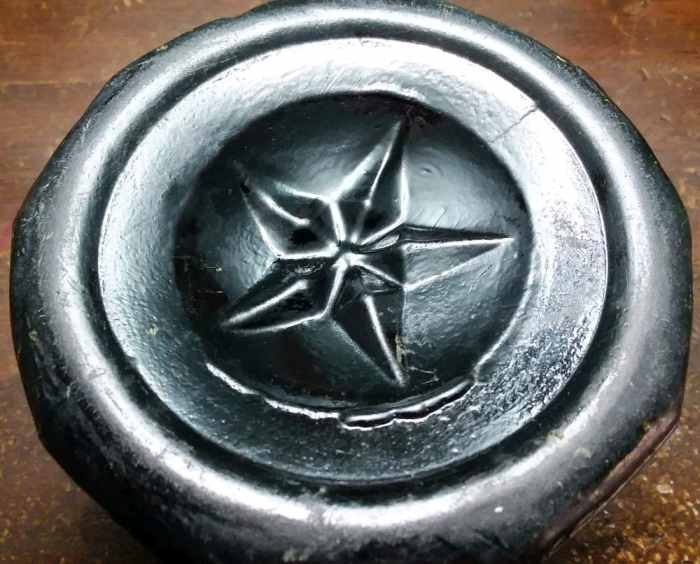
Several other ale-type bottles, dating from the early 1870s period and marked with the star emblem on the base, are believed to be products of Star Glass Works. These include bottles blown for (marked): Madison Original Ale – John Fennell; Schnabel & Nadorff; Adam Bez; Shuck’s West End Ale; Coleman & Co.; Oberriella & Lehman and Jennerich & Epping. All are also lettered with the city name “LOUISVILLE, KY”. (This list is gleaned from information published in the reference book “Louisville Breweries: A History of the Brewing Industry in Louisville, Kentucky, New Albany and Jeffersonville, Indiana” by Peter R. Guetig and Conrad D. Selle – 1995).
Note: there are MANY different antique bottles found around the United States that have some type of star marking on the base. Sometimes the mark is merely a decorative device, or served as a mold identifier. In other cases it stood for a glass factory. The star used by Star Glass Works has a characteristic “look” that is somewhat different from others. The center of the star is somewhat “sunken” and there are always five rather boldly delineated points or “petals”, and each point has a shape somewhat reminiscent of a teardrop or a pear with an angular diamond-like design. Each “diamond” has four facets. The strap side flask (base shown below) is attributed to Star Glass Works, but I can’t say with 100% certainty that it was made there.
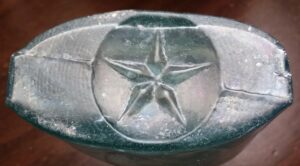

The “star” bottle mark shown above may, or may not be related to Star Glass Works!
It is possible (not proven) that the Clasped hands / Eagle flask listed in the McKearin flask chart as GXII-12 is a product of Star Glass Works. There is a star on the bottom of that flask. (The star-marked base type is deemed “Type 14” in the landmark reference work on flasks – “American Bottles and Flasks and their Ancestry” by Helen McKearin and Kenneth Wilson, 1978). If anyone has information that might help prove (or disprove) this idea, please contact me! The GXII-12 type might have been made at another glass works with “Star” in it’s firm name, or possibly the base star is just a decorative emblem.
There is also a well-known wax sealer style fruit jar with the lettering “Star Glass Co. / New Albany Ind” across the front. Those jars are found in quart and half-gallon sizes, and in several colors including aqua (most common), green aqua, and (rarely) in green, medium blue and amber. They might date from the early and mid-1870s.
The later DePauw operation produced large quantities of “Mason” style fruit jars, marked “MASON’S / PATENT / NOV 30TH / 1858” on the front, some marked “W. C. D.” (in an arc, above a mold number) on the base. They are found in 3 sizes, and in a range of colors including aqua, yellow amber, olive amber and citron. (Please note that the NOV 30TH 1858-type jars were made by MANY glass companies, so the only ones that can be positively attributed to the New Albany factory are those with the “W. C. D.” embossing on the base).
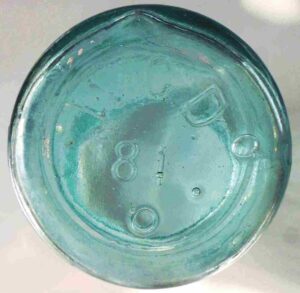
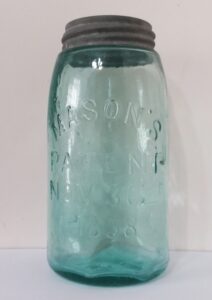
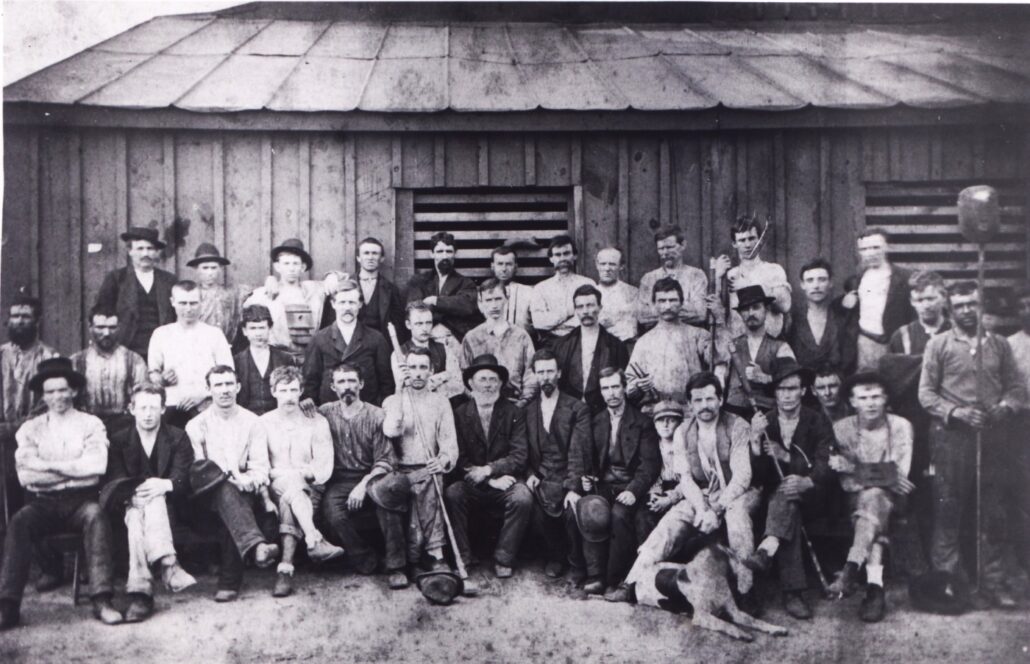
This photograph was taken showing the glass workers of the window glass department (“Window House”) of the Star Glass Works (W. C. DePauw Glass Co.) factory in New Albany, Indiana, date unknown but possibly circa 1882. According to information submitted by Hale Anderson (at the time he donated this photograph to the New Albany- Floyd County Public Library) the following were identified as:
Row one, seated, from left to right: Tom Wall (1st); Otis Roy (6th, holding blowpipe); and ? Herschman (7th).
Row three, from left to right: Conrad Wilhelm Fleischer (1st); Levy Pierce (5th); John Cox (6th); ? Bryant (8th); Will Owen (9th); and his son, Sidney Owen (10th). Out of 39 workers, only 9 are identified! If you have any information that could help identify any of the other employees in this photograph, any assistance would be greatly appreciated!
INSULATORS??
Local author/historian Gerald O. Haffner, in his book The Glass Industry of New Albany (1983), writes, on page 44, that glass “telephone pole” insulators were produced by Star “after 1876″, apparently referring to contemporary newspaper articles. (I do not know exactly what articles he is referring to. In April 1995 I personally wrote to Haffner and asked for clarification on the subject of possible insulator production at Star. At that time he was in Florida with all his reference material in storage, and couldn’t answer my questions, other than to tell me that mention of insulators was made somewhere in local newspaper articles of the time period in question. I was not able to find that reference, although I may have missed it as I haven’t scrutinized every single newspaper article from those years.)
In any case, at the present time, no actual insulators are confirmed to exist that have been shown to be products of this factory. If any insulators were made by Star, (which is certainly not out of the question), they would presumably be unmarked, and, at present (2017), still unattributed / unidentified examples.
NOTE: None of the glass electrical insulators with embossed 5-point “STAR” markings were manufactured here. They are of a somewhat later era (c. 1900-1915) and were made by (principally) three glass companies: Novelty Glass Company, Elmer, NJ; Sterling Glass Company, Elmer, New Jersey; and Harloe Insulator Company, Elmer, NJ & Hawley, Pennsylvania. In addition, some of the “star” insulators might have been produced by Brookfield Glass Company.
Research done by N. R. Woodward, Ray Klingensmith, and Frank Swies over the last few years has shown that there cannot be any connection between Star Glass Works of New Albany, IN and the glass insulators marked with a star which were actually marketed in large quantities by General Electric Supply Company.
See my webpage on the New Albany Glass Works.
Other glass companies that operated in the Louisville, KY area in the late 19th century include: Southern Glass Works, Kentucky Glass Works Company, and Falls City Glass Company.
Please click here for the website Home Page.
Please click here to return to the Glass Bottle Marks pages.
ADVERTISEMENT

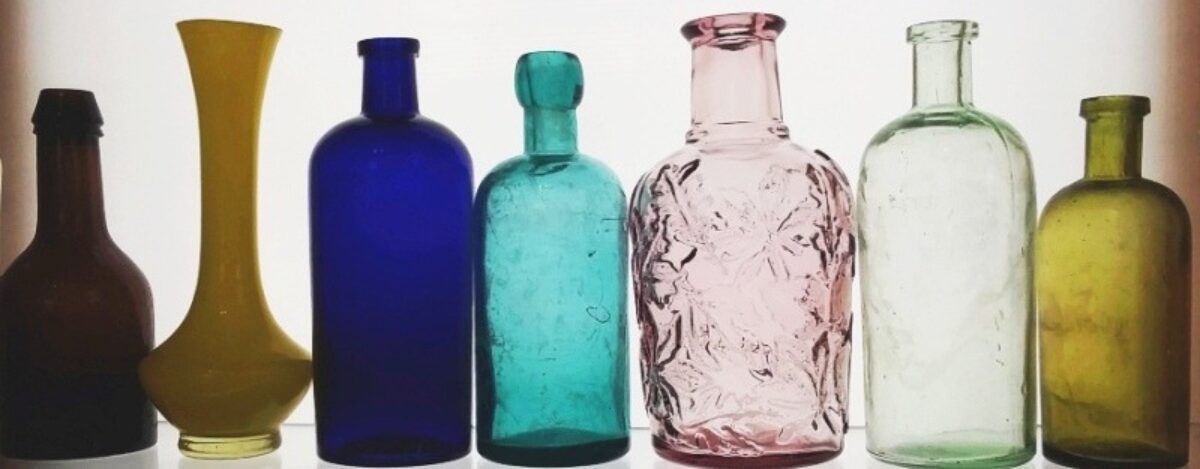
I am writing a brief history of PPG for Western Pennsylvania History Magazine and would like to include the photo captioned “Star Glass Company historical marker at 10th Street (south of Main) in New Albany, Indiana”. Can I have your permission to do so?
Many thanks,
Bill Huber
Hi Bill,
Sure, go right ahead. If you would, please credit the photo to “David Whitten”. I believe I took that photo in 2017.
Best regards,
David